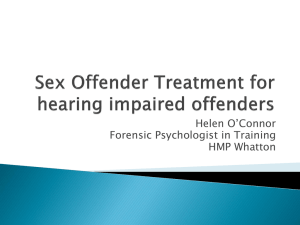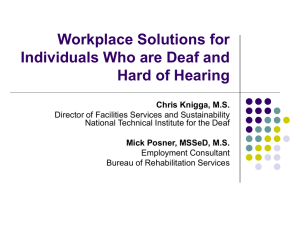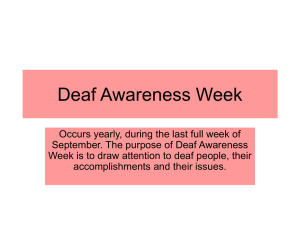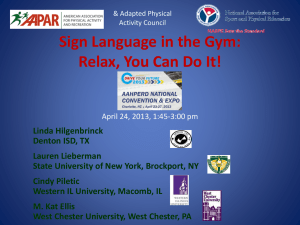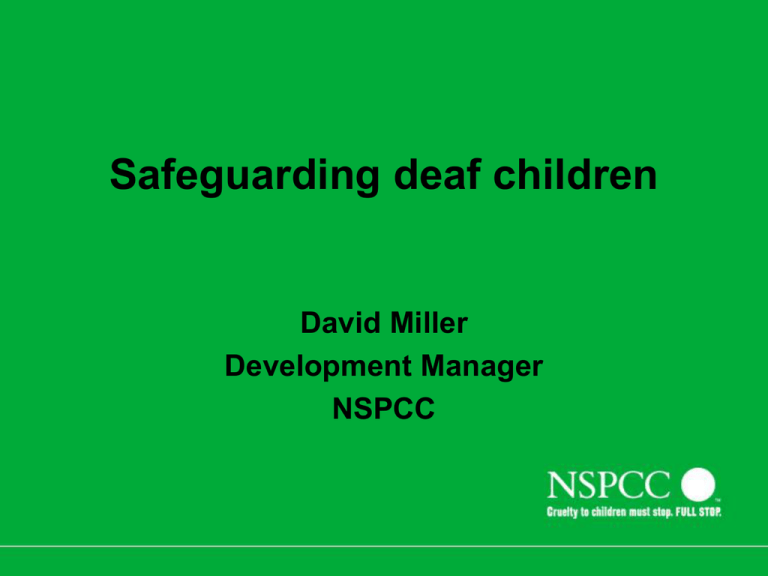
Safeguarding deaf children
David Miller
Development Manager
NSPCC
Risk of abuse
Disabled children 3.4 times more likely to be
abused
•
•
•
•
3.8 neglect
3.8 physical abuse
3.1 sexual abuse
3.9 emotional abuse
Sullivan and Knutson (2000)
Risk of abuse
• 45.8% of deaf girls and 42.4% deaf boys
exposed to unwanted sexual experiences
• More than twice as often for girls and three times
for boys compared to hearing children
• Nearly half reported the abuser was deaf
• Half of abuse took place in special schools
• 49% didn’t tell. 11% were not believed
Kvam (2004)
Risk of abuse
• Research indicates that disabled children are
significantly more likely to experience abuse
than their non-disabled peers
• Evidence suggests increased vulnerability for
children with communication impairments,
behavioural disorders, learning disabilities and
sensory impairments (compared to disabled
children as a whole)
Stalker and McArthur (2012)
Bullying
•
•
•
•
•
•
Every child knew about bullying
Evoked high levels of feelings
Most had been bullied
More than half had bullied others
Many ideas and suggestions
Adults should take it seriously
Triangle consultation for NSPCC 2007
Reasons for increased risk:
Attitudes and assumptions
• Devaluing of deaf children, their experiences and their
needs
• Lack of awareness about cultural issues or deaf
development issues
• Reluctance to believe that deaf children are abused
• Lack of recognition of the possible impact of abuse
• Low commitment to overcoming communication barriers
• Attributing indicators of possible abuse to child’s
deafness eg child’s mood, behaviour
• Reluctance to challenge parents/carers
Gaps in effective provision of
support services
• Inaccessible community and support services
• Lack of consultation and empowerment of deaf child
• Lack of: personal safety skills education; accessible
information and access to confidential advice
• Skills gap between workers with deaf children and
children protection
• Lack of child focus in assessments
• Lack of co-ordinated multi-agency working
• Resource constraints
The deaf child and social
interactions
• Social exclusion and isolation
• Poor self esteem, self-image and self-confidence
• Lack of vocabulary and awareness to understand about
abuse and be able to seek help
• Limited trusted sources of support with relevant
communication skills to turn to for help
• Deaf child specifically targeted
• Inappropriate attitudes and behaviours resulting from
abuse, especially where child’s therapeutic needs
unmet
Barriers to recognition of abuse
Second Joint Chief Inspectors’ Report into Safeguarding
(2005):
•Significant issues in identifying and acting on welfare
concerns
•Child protection policies inconsistently adapted to take
account of the needs of children and young people with
communication, sensory or learning difficulties
•The views of many disabled children are not heard
•Staff in a range of settings are not consistently trained in
child protection and safeguarding to meet the needs of
disabled children.
Barriers to recognition of abuse
Protecting disabled children: Thematic inspection (Ofsted 2012) some
key issues:
• Early concerns and emerging risks mostly tackled well
• Children in need work not always well co-ordinated.
• Many plans lacked detail and focus on outcomes.
• Reviews did not always include all professionals working with the
child
• Lack of rigour increased the likelihood of child protection concerns
not being identified early enough
• Delays in identifying thresholds for child protection when concerns
less clear cut, especially neglect
• Assessments not consistently identify and analyse key risk factors
leading to delays in support and intervention
Children’s Services, deaf children
and child protection
• Only 37% responding Local Authorities described coworking arrangements between child protection teams
and specialist social workers
• 18% no co-working arrangement at all
• Others described various arrangements for getting help
of different varieties within or outside the Local Authority
Young, Hunt, Oram and Smith (2009)
Safeguarding deaf children
Key issues
• Valuing deaf children and their experiences
• Accessible community and support services
• Policies and practices that safeguard deaf
children and promote their wellbeing
• Empowering deaf children
Safeguarding deaf children
• Developing own awareness of safeguarding and deaf
children
• Consulting with and empowering deaf children
• Advocating for the deaf child’s wellbeing
• Developing sex and relationship and safety skills
education and vocabulary
• Ensuring opportunities for deaf children to seek help
• ‘Listening’ to the child and responding to concerns
• Appropriate identification of thresholds
• Effective multi-agency working
Safe: Personal Safety Skills Programme
Pilot: 3 schools with deaf children:
•
•
•
Sign bilingual
Total communication
Oral
Aims of programme
Provide children with knowledge, awareness,
information and language to:
• Keep safe
• Make more informed choices
• Strengthen identity, self confidence and selfesteem
• Explore and understand experiences
Topic areas
•
•
•
•
•
•
•
•
•
•
Feelings
Relationships
Differences
Bullying
Growing up, including sex education
Personal safety in the home
Personal safety outside the home
Road safety
Safety using the internet / mobile phones
Someone to turn to
Working with Deaf and Disabled
Children
•
•
•
•
•
•
•
•
Information: Easy read, audio, BSL
Visual materials
Examples – scenarios, varying context
Role plays
Puppets
Exercises
Reinforcing messages – school, home etc.
Rolling programmes
Examples of storyboards
Feelings
Differences
Bullying
Some observations from delivery of
the programme
• Many children lacked the appropriate language,
vocabulary and awareness to be able to communicate
abuse – including post 16 plus
• Some had very limited (or no) knowledge of sex
education
• Professionals often lacked confidence and/or knowledge
to deliver the programme
• Several disclosures were made during the piloting
• Referrals were made to Social Care and Health
• Professionals learnt new information about the children
and young people



